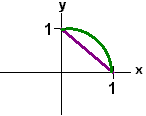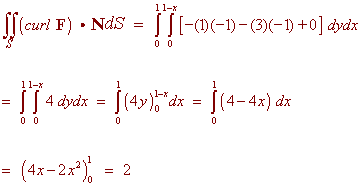| Practice 3 Please work out each of the given problems. Credit will be based on the steps that you show towards the final answer. Show your work.Problem 1 Please answer the following true or false. If false, explain why or provide a counter example. If true explain why. A. Let f(x,y,z) be a function with continuous second order partial derivatives and let F(x,y,z) be the gradient of f(x,y,z). If S is the ellipsoid x2 4 oriented outward, then False Using the divergence theorem, we have If gradf(x,y,z) = F, then divF = fxx + fyy + fzz There theorem would be true if the function was harmonic, however if it not harmonic. All bets are off. For example, if f(x,y,z) = 1/6 (x2 + y2 + z2) and divF = 1/6 (2 + 2 + 2) = 1 Hence the integral represents the volume of the ellipse which is certainly not zero. B. Let F(x,y) be a conservative vector field, then  True, The first line integral traces out the line segment from (0,1) to (1,0) and the second traces out the quarter-circle from (0,1) to (1,0). Notice that in the first integral  r1(t) = (1 - t)i + tj r1'(t) = -i + j and in the second integral r2(q) = (cos q)i + (sin q)j r1'(t) = (-sin q)i +(cos q) j By the fundamental theorem of line integral, the integral is independence of path, hence the two integrals are equal. Problem 2 Show that for any closed surface S. Where C is the boundary of the surface S. But since S is a closed surface, it has not boundary. Hence C is a curve of zero length and the right hand integral is zero. Problem 3 A fish starting at the origin swims in a straight path to the point (0.2,0.1,0.3), then changes direction and swims along the circular path through the point (0.5,0.2,0.6) and the point (0.7,0.5,0.8), and finally changes directions heading straight to the point (1.5,1,2). The current can by represented by the vector field F(x,y,z) = (2x + 2z)i + (1 - 3z)j + (2x - 3y + 5)k Find the total work done by the current. The important thing to not here is that  Since F is conservative, we can use the fundamental theorem of line integrals. We seek a potential function f. We have fx = 2x + 2z Integrating with respect to x gives f = x2 + 2xz + C(y,z) Now taking the derivative with respect to y gives fy = Cy(y,z) = 1 - 3z Integrating with respect to y gives C(y,z) = y - 3yz + C(z) so that f = x2 + 2xz + y - 3yz + C(z) Now we take the derivative with respect to z to get 2z - 3y + C'(z) = 2x - 3y + 5 so that C'(z) = 5 Integrate with respect to z to get C(z) = 5z Hence f(x,y,z) = x2 + 2xz + y - 3yz + 5z The fundamental theorem of line integrals gives that the integral is f(1.5,1,2) - f(0.2,0.1,0.3) = [(1.5)2 + 2(1.5)(2) + 1 - 3(1)(2) + 5(2)] - [(0.2)2 + 2(0.2)(0.3) + 0.1 - 3(0.1)(0.3) + 5(0.3)] = 11.58 Problem 4 Evaluate  and S is the rectangular solid with vertices (0,0,0), (1,0,0), (1,2,0), (0,2,0), (0,0,3), (1,0,3), (1,2,3), (0,2,3). divF = 1 - 1 + 2 = 2 We have Since the integrand of the right hand side is just a constant, its value is equal to the constant times the volume of the solid. Since the solid is a rectangular solid with side lengths 1, 2, and 3, we have 2(Volume E) = 2(1)(2)(3) = 12 Problem 5 Find the work done by sailing a ship from the point (2,3) the the point (-1,2) against the wind with velocity field F(x,y) = yi + (3x + 2y)j r(t) = (2 + (-1 - 2)t)i + (3 + (2 - 3))j = (2 - 3t)i + (3 - t)j We have dr = -3i - j F(t) = (3 - t)i + (3(2 - 3t) + 2(3 - t))j = (3 - t)i + (12 - 11t)j The integrand becomes F . dr = -3(3 - t) + (-1)(12 - 11t) = -21 + 14t Now we integrate  Problem 6 Find the flux of F through the surface S where F(x,y,z) = 3zi - 4j + yk and S is the part of the plane x + y + z = 1 in the first octant with upwardly pointing unit normal. We use Stokes' theorem. We have  We can write the surface as z = 1 - x - y Using Stokes theorem we get  |
MANIC FM
Saturday, July 24, 2010
Vectors Calaulus 1.35
Subscribe to:
Post Comments (Atom)
No comments:
Post a Comment